| 1 | East diamondback rattlesnake |
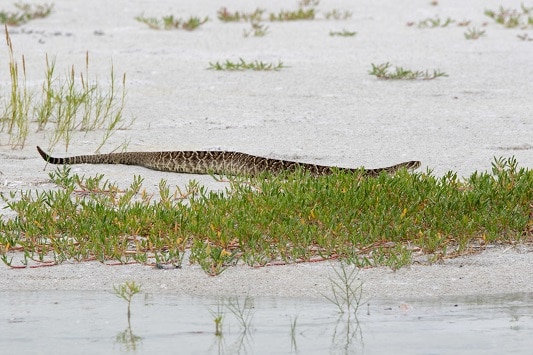
A severely venomous beach snake which can reach 240cm. Eastern diamondback rattlesnakes mainly reside in palmetto flatwoods and longleaf pine forests, yet stray to sandy beaches regularly, in their Florida, Georgia and Alabama territories. This is a determined, patient snake which prowls through the sand slowly, not wanting to announce its presence. Their venom has a 10-20% fatality rate, yet charging down beachgoers is very unlikely, no matter how terrifying their sudden appearance may be.
Despite their heavy bodies, eastern diamondbacks are also great swimmers, and have been spotted a couple of miles offshore in the Florida keys. This is the sort of beach snake that can appear from nowhere. You can wander over to an ice cream parlour 100 metres away enjoying the sun, only to have your way completely blocked by a 2 metre rattlesnake when you attempt to return.
Fortunately, eastern diamondbacks aren’t too manic, preferring to find a comfortable corner of a beach and stay there, relaxing just like any other beachgoer. If you’re lucky, you might never realise that they’re there, instead mistaking a distant dark shape for a dried out palm tree branch.
| 2 | Carpet python |
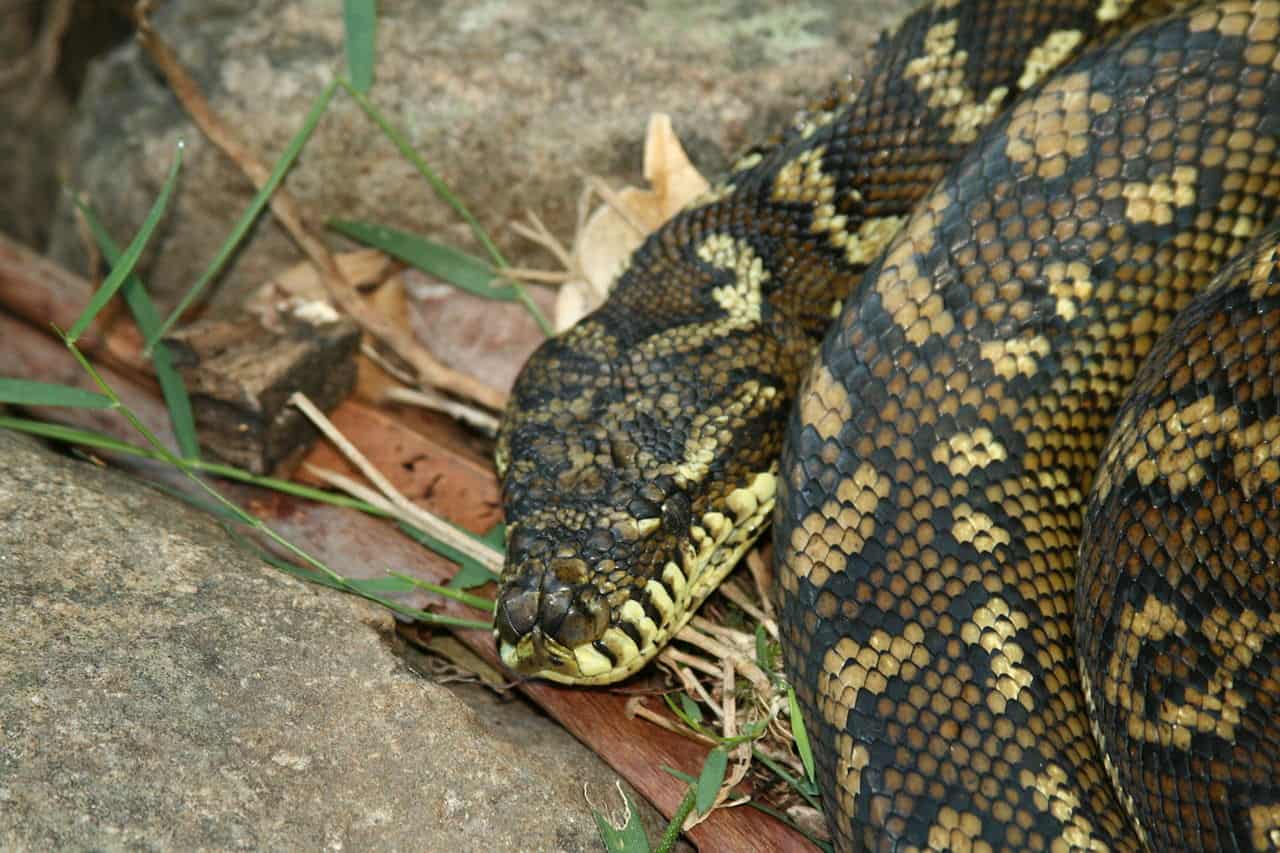
This 3 metre constrictor is a regular sighting on eastern Australia’s beaches, amidst a landscape of sea shells and seaweed. A recent sighting in 2023 involved two males wrestling each other, presumably to gain the affections of a nearby female. This took place on Mudjimba Beach on Queensland’s Sunshine Coast, and the beachgoers didn’t seem too bothered. This youtube video shows veteranarians removing a beach towel from a carpet python’s stomach, garnering over 50 million views.
Locals are used to them, taking no notice as they walk past in sandals, whereas tourists have no idea and will encounter a slithery surprise, perhaps just as they’re about to lay down their beach mat. Carpet pythons primarily eat mammals, which are in healthy supply in thickets just next to the beach.
Carpet pythons rarely bite, and could slither over your belly as you sunbathe, meaning no harm. Their defensive tactics mainly involve fleeing or a harmless headbutt, and unlike a reticulated python, they’re not large enough to swallow a human. If you hold your nerve, you could easily find a nice untouched beach to yourself which most tourists are too scared to visit. Carpet pythons move slowly, seeming patient rather than nervous and agitated.
| 3 | Mexican burrowing python |
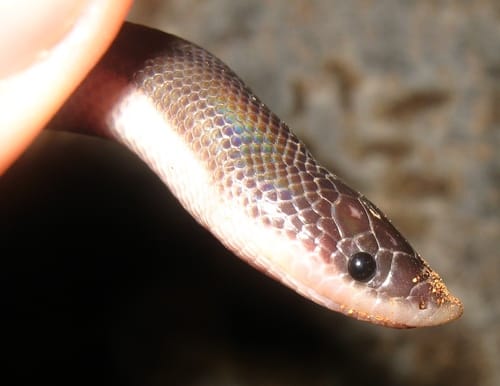
A resident of Central America, an ambushing constrictor which has no close relatives. Mexican burrowing pythons lack venom, reach 1-1.5 metres, and primarily eat turtle eggs. They have a chocolate colour and very smooth scales, to enable its specialised tunnelling lifestyle. Mexican burrowing pythons live not just in woodlands with loose soils, but on sandy beaches, which are perfect for digging down to create a new tunnel network.
Theoretically, though you’d have to be very lucky, you could dig down with a bucket and spade and accidentally unearth one of these beach snakes. One beach they inhabit is Ostional beach in Costa Rica, which is famous for its large colonies of olive ridley sea turtles and Kemp’s sea turtles.
Many underground snakes simply enlarge tunnels created by other animals, but Mexican burrowing pythons forge their own. Rather than reversing out backwards, Mexican burrowing pythons press ahead and forge a new tunnel when they wish to leave. This means that beachgoers could get a massive shock as a curious looking snake head pops up. The snake would likely be startled, and burrow back down into the sand again, leaving you to insist to your buddies that this far-fetched tale really happened. The Mexican burrowing python is most abundant on the Pacific coast of central America, as opposed to the Caribbean coast.
| 4 | Corn snake |
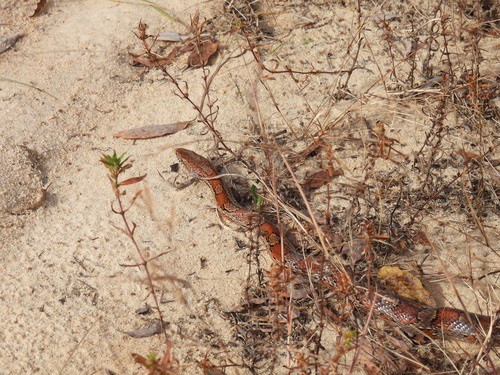
Corn snakes are another invader of Floridian beaches, as the winner of a photography contest from 2023 shows. Corn snakes are active foragers which grab small mammals through whatever means possible, charging or sneaking up slowly. They’re a completely harmless beach resident, which lacks venom and constricts their prey.
This species might give you a shock if you doze off in the sun while reading a book, only to suddenly awaken with a serpent face staring at you. This is a slow-moving snake, yet one which can disappear in a heartbeat, seeming like a mysterious apparition of the sun. A small child could easily run up to his mother, and swear that he saw a snake, only for the doubting mother to stride over and find nothing. These stories probably become matters of family lore, being debated at the dinnertable for decades to come.
Search for the distinctive red-yellow patterns if you want to recognise this beach snake, plus beady black eyes. Corn snakes mainly live in spacious woodland, crop fields, and thickets, but beaches are no problem for them. Corn snakes also like the shaded edges of beaches, so keep an eye out on the walk from the car park
| 5 | Banded sea snake |
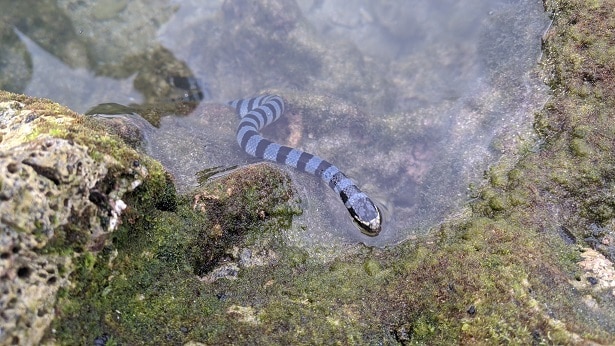
This black and white sea snake is a common sight on the beaches of southeast Asia. It spends 60% of its life underwater, and 40% resting on dry land, and can create vast colonies on sparkling white beaches, where they lie around barely moving.
Phuket in Thailand and Amadee Island in New Caledonia are particular hotspots, the latter being popular with tourists for its lighthouse. The island has a scenic wooden platform of small boats to dock on, and the visitors are often shocked by the amount of snakes lying around. Guides are then forced to point out that the banded sea krait has caused extremely few human deaths.
This species does have a neurotoxic venom, whose potency outstrips both the eastern diamondback and king cobra gram for gram. The difference is that they’re completely non aggressive, and usually only react if touched. In fact, it’s debateable whether they even notice you unless you stray to within 1 metre. Banded sea kraits land on beaches to breed and digest food, not hunt, and like most sea snakes, they have dodgy vision at the best of times.
| 6 | Dugite |
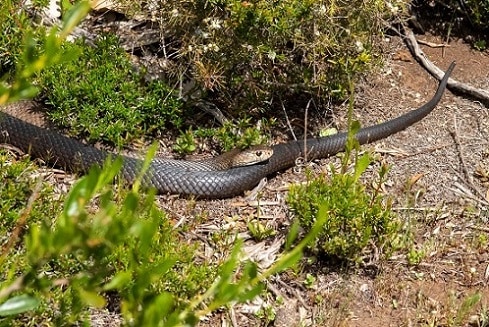
A west Australian snake which immobilises prey with a nasty venom, venom which it can also turn against predators (e.g. humans). Dugites (Pseudonaja affinis) are one of the worst threats a beachgoer could face, as they’re normally calm, but turn savage if cornered, even if you accidentally bumped into them. Your day could turn from holiday to horror, with distinctive symptoms including a metallic taste in the mouth and paralysis.
Fortunately, deaths are rare, as antivenom is stocked in all Australian hospitals (unless they ran out the previous day). One incident happened in 2021 at the popular Whitford’s beach in Perth. Initially, the beachgoer thought it was a piece of rubbish, but it was actually a dugite swallowing a king skink.
Exactly whether a beach would mention this snake to tourists is undetermined. As Jaws shows, tourism hungry towns would rather not mention that their beach is home to murderous creatures while beaches just a few miles away are home to happy dolphins instead. There’s also large stretches of wild, barely visited beaches in western Australia where this cunning serpent could potentially pop up. In addition to sandy beaches, dugites inhabit parks, agricultural fields, and golf courses.
| 7 | Cape cobra |
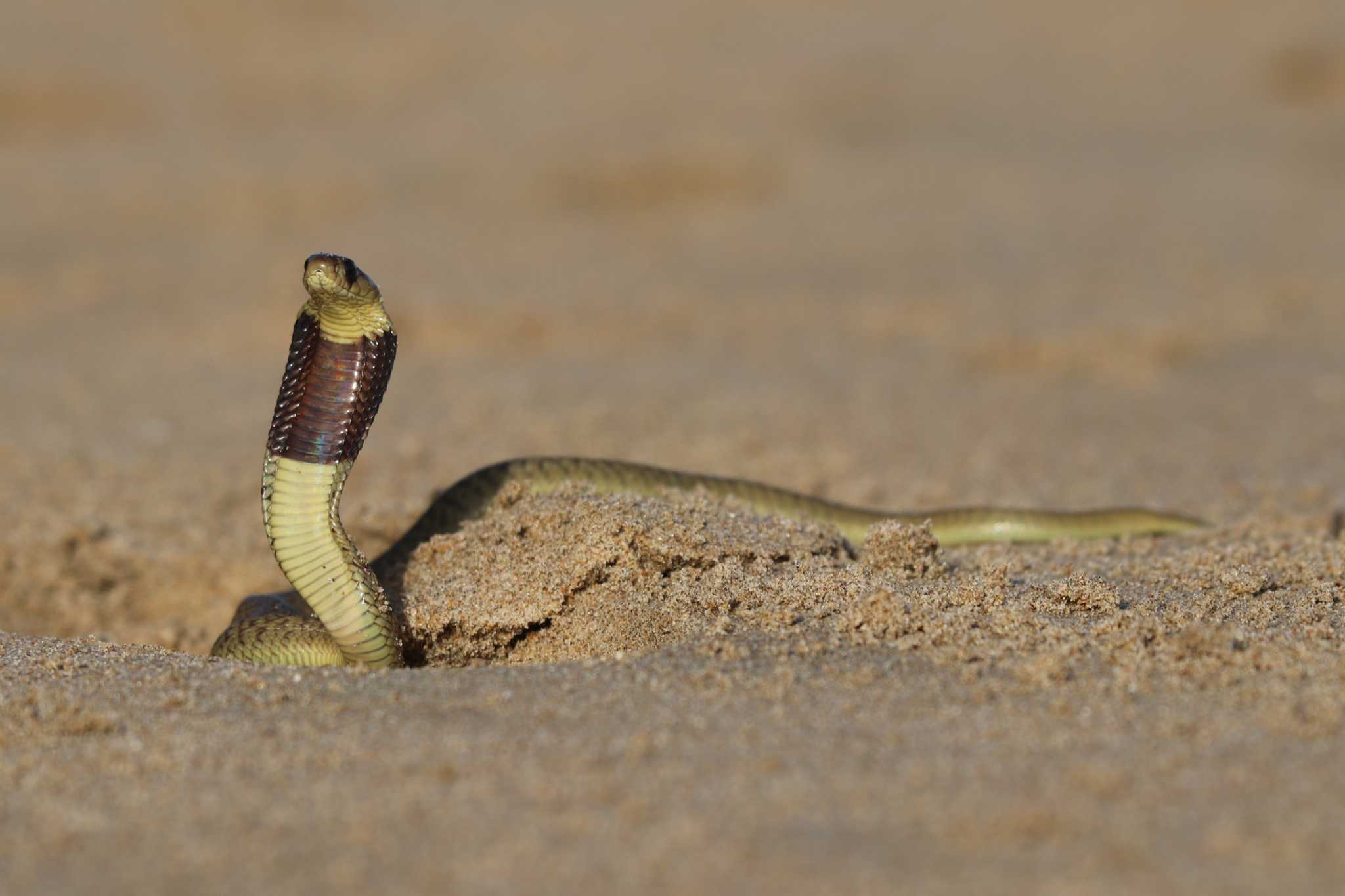
The main cobra of southeast Africa, particularly South Africa and Mozambique. Cape cobras reach 1.5 metres and are agile and fast, with twitchy neck movements as though they’re incapable of relaxing. The cape cobra is an adventurous species which moves dozens of metres per day and doesn’t stick to one location. If tantalising scents drift over from a nearby beach, perhaps from a flock of seagulls, then they wont hesitate to slither along the white sand and investigate.
Many cobras have caused entire beaches to empty as the first sight of their raised neck appears in the distance. The cobra usually takes no notice, scanning around alertly as panicking tourists hastily pack up their beach bags and flee.
Worse, cape cobras are excellent simmers, and have been spotted speeding through the sea by people enjoying the water. Cape cobras have no special attraction to beaches, but no area is out of bounds for them. They can patrol whatever landscapes they feel like, excluding true deserts and frigid mountaintops.
| 8 | Beaked sea snake |
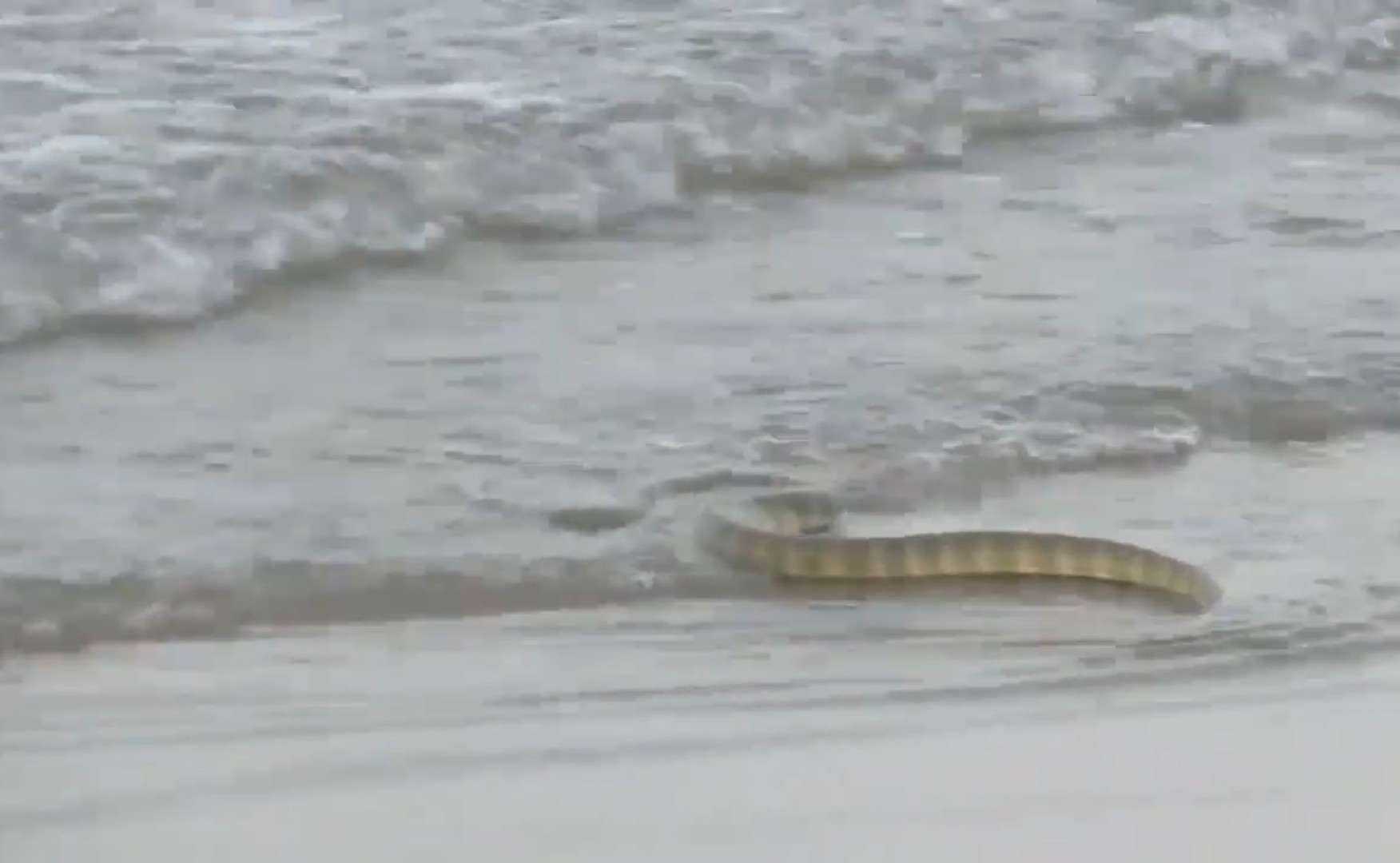
This sea snake inhabits a huge area of coastline from India to Australia, and measures 120cm on average. Hydrophis schistosus can reach several kilometres off shore, and dive to 100 metres, holding their breath for 5 hours. But they also flop onto beaches occasionally, relaxing in the shallow tide, knowing that they’ll be sucked back in with a little patience.
Sightings of this snake are particularly common on Indian beaches, where it’s one of the most common sea snakes overall. Unfortunately, this species also causes the most deaths, perhaps 90% of all sea snake fatalities. Hydrophis schistosus has a cantankerous personality, biting readily, and just 1.5mg of its venom is capable of killing a human being. Suffice to say, you should turn around and run far if you see Hydrophis schistosus on a beach, or at the very least not poke them.
Compared to banded sea kraits, this beach snake has the advantage of blending in easily. Its beige and grey scales are a close match for sand mingled with the shallow tide, and stepping on one is a real danger.
| 9 | Loo-choo big-tooth snake |
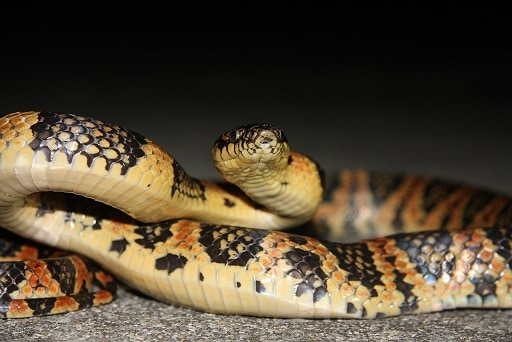
The Loo-choo big-tooth snake is a 1-1.5 metre snake of Okinawa, Japan, in addition to many smaller islands of the Ryukyu island chain, such as Yakabi and Kuma island. Few have heard of them, but in certain Japanese locations, this little known snake is a mainstay of scenic local beaches, including undeveloped secret beaches which few tourists have noticed.
In a paradise of white sand and turtles, you can find this humble snake attempting to survive by burrowing into the sand to find turtle egg nests to raid. These snakes are known to eat eggs of the green sea turtle and loggerhead sea turtle, which use sandy beaches as their main nesting sites.
Lycodon semicarintus is a simple part of the scenery in these obscure Japanese beaches, known by locals but forgotten by the rest of the world. Tucked away in a peaceful island realm, they go about their lives quietly and calmly, with turtles and the occasional dolphin as their neighbours. Sometimes, one Loo-choo big tooth snake forges the initial tunnel to the turtle egg nest, and then other snakes will arrive from elsewhere on the beach and exploit the ready made tunnel.
| 10 | Little filesnake |
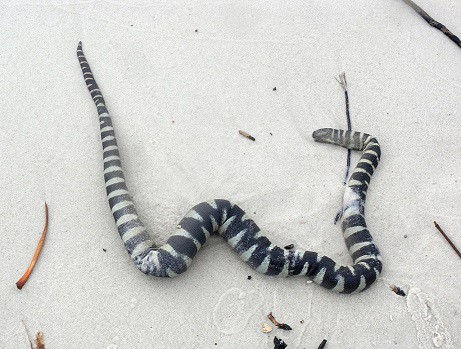
The smaller relative of the elephant trunk snake, which looks a lot less like an elephant trunk. Little filesnakes measure 40-60cm and can be found 20 miles out to sea, but commonly washes onto beaches to rest, particularly along the Indonesian coast. This species has no mad wish to remove tourists from the beaches, it simply wishes to relax for a while away from the ocean.
Little filesnakes live from the Indian to Australian coast, and have various adaptions such as blood which is twice as thick in red blood cells as normal, for capturing additional oxygen underwater. If you see one while unrolling your sunbathing towel, then there’s nothing to fear. The little filesnake is utterly useless on land. As newborns, they can slither decently, but in adulthood, their scales develop a wartiness which reduces them to a snail grind, moving centimetre by centimetre, until they finally reach the tide and disappear back into the comforting ocean.
Little filesnakes mainly eat sleeperfish and gobies, though they only hunt in the sea. Though harmless, it might be disturbing if you witness the moment the waves deposit one on the beach, as though the ocean is deliberately trying to get rid of you. This species is only distantly related to most sea snakes – their Acrochordus family is highly isolated and considered to be an evolutionary anomaly.
